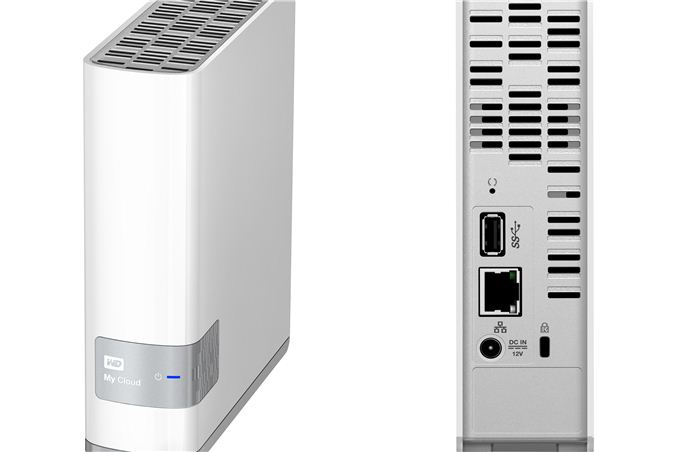Western Digital Launches My Cloud Consumer NAS Platform
by Ganesh T S on October 2, 2013 8:00 AM EST- Posted in
- Western Digital
- Storage
- NAS

The network attached storage market is growing by leaps and bounds. While the SMB (small and medium business) / enterprise market is driven by speed, IOPS and concurrent access support, the consumer segment is primarily driven by capacity and ease of use. Vendors have typically targeted the consumer / SOHO NAS platform with RISC-based chipsets, while Atom-based units target the higher-end SOHO and SMB market. Western Digital's SMB NAS units run Windows Storage Server (the Sentinel series), but they also have a Debian Linux platform for consumer units. We have evaluated the Linux-based My Book Live before. Running on the Applied Micro APM82181 PowerPC-based platform, the unit earned our recommendation for the extreme ease-of-use and mobile app ecosystem.
Today, Western Digital is announcing a very ambitious update to the My Book Live. At launch, the new My Cloud lineup will have only one member. This member, a network attached hard-disk, will come in 2, 3 and 4 TB capacities priced at $150, $180 and $250 respectively. However, under the same lineup, Western Digital also plans to bring out two and four-drive configurations to the market soon.
The My Cloud units sport a single Gigabit Ethernet connection and a dual-core processor (WD refused to disclose the identity, but it should become apparent when we receive units in hand). The units are backed by free iOS and Android apps (with direct upload from the mobile device to the NAS as the main feature) as well as well as the WD SmartWare Pro software for PC backups. Time Machine support is also available for Mac users. The units are also compatible with DLNA devices as a DMS (Digital Media Server).
The launch of the My Cloud lineup will definitely heat up the competition in the consumer NAS segment. WD's storage background will also help in making the units hit an optimal price point. Interesting aspects to look forward to would be whether the two and four-drive units will have removable drives and/or hot-swap capabilities. We are looking forward to review one of these when the multiple-drive versions hit the market.










27 Comments
View All Comments
nathanddrews - Wednesday, October 2, 2013 - link
"The My Cloud units sport a single Gigabit Ethernet connection and a dual-core processor"Looks like it also has a USB (3.0?) port.
Cool that it has a Gbit port! Would one be able to connect a lot of these to a single network and access them all easily? Perhaps a very cheap way to have a massive, low power array...
Kevin G - Wednesday, October 2, 2013 - link
That doesn't look like a standard USB 3.0 port though.xype - Wednesday, October 2, 2013 - link
Logo looks like USB 3.0 Super Speed, though, or?hlmcompany - Wednesday, October 2, 2013 - link
This is a USB Type 'A' port, which makes the My Cloud the host. Therefore, this USB port, although it supports USB 3.0, is designed to attach extra storage to the My Cloud, not for the My Cloud to be connected to a host system via USB.nathanddrews - Wednesday, October 2, 2013 - link
Which begs the question: just how many of these can we chain together? How do they interact with one another?Ganesh?
hlmcompany - Wednesday, October 2, 2013 - link
Considering this is a USB Expansion Port and we're provided with a single Gb port, it would seem that we wouldn't be able to chain-together any My Cloud units. We could connect a regular My Book unit to a My Cloud via USB. This is similar to the My Book Live Duo.Guspaz - Wednesday, October 2, 2013 - link
I've seen external 2.5" hard drives with a USB-A port on them. It's not unheard of.nathanddrews - Thursday, October 3, 2013 - link
I've got external HDDs that use both A and B ports. I think it only matters if the device is powered by USB, but I don't really know.Xajel - Wednesday, October 2, 2013 - link
Very attractive price, design and features... now I'm really waiting to see the multi drive solution, I hope it will have attractive price also I don't know why somebody will pay 150+ for only a bare 2-bay NAS enclosure !!...The only feature I'm missing from these NAS which is very hard to implement also is using both USB and Network in the same time... I want to connect the drive to my main PC with USB and also allow other devices in my home to access it by network... without the need to make the PC runs 24/7... but I can live without that if it like this, Gigabit Ethernet and attractive price...
kineticarl - Wednesday, October 2, 2013 - link
That seems redundant. If the drive and your main PC are both wired to your router, the Gb connection should be quick enough to rival a USB connection, shouldn't it? And you can map it as a drive so that it would be pretty much indistinguishable from a USB connection.